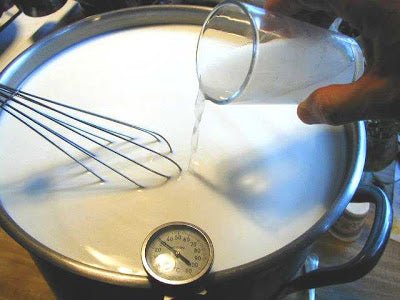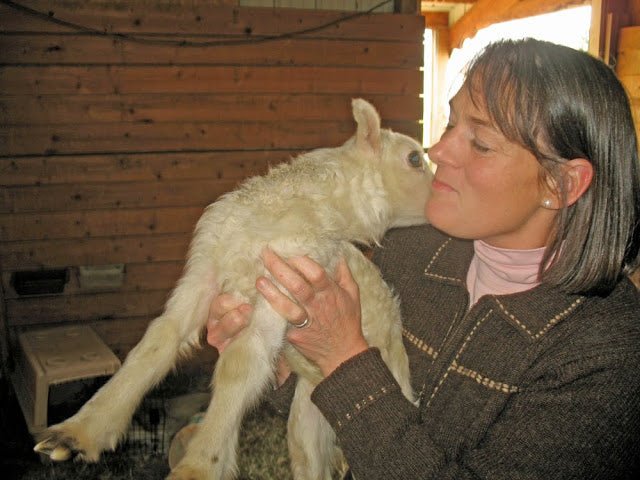
Making Friends With Those Little Enzymes
“The biology of cheese accurately reflects the biology of nature. Its reactions for the most part, except on cheese surfaces, occur in a confined almost airless environment in which millions of microbes struggle toward some progressive goal, usually that of keeping alive.” –Cheese and Fermented Milk Foods, Kosikowski, Volume I, p. 417
 What do you mean? Picture this:
What do you mean? Picture this:
You milk your cow or goat or sheep and carefully carry the milk to the milk vat. Within 24 hours, you slowly heat this milk to the right temperature and add the starter cultures. You gently handle the curds through the rest of the process and then you put the cheese in the cave to age. Slowly, over time, the cheese develops that “picante” flavor and silky texture you love so much.
If that’s the way you make your cheese, congratulations and you can stop reading now! You are treating your lipase friends with the respect they deserve and they will serve you well.
 Now, picture this:
Now, picture this:
You go to the store and buy pasteurized milk because in the area where you live, you can’t buy raw milk. You patiently and carefully do everything you can to make your cheese properly. You put it in the aging “cave” you have made and wait for many months. You try your cheese, and it’s good, but not like the cheese you love so much. Where is the flavor?
Well, to be blunt, your little lipase friends were killed when your milk was pasteurized. Simple as that.
 When milk is treated roughly (churned or agitated), the fat globules get broken. The lipase enzymes (ever vigilant) are just waiting for that opportunity to attach themselves to the broken part and begin their job. If they begin working before the milk is turned into cheese, the cheese will not age properly. (Areas of it go rancid before the rest has even developed flavor.) This is why cheesemakers handle their milk so carefully.
When milk is treated roughly (churned or agitated), the fat globules get broken. The lipase enzymes (ever vigilant) are just waiting for that opportunity to attach themselves to the broken part and begin their job. If they begin working before the milk is turned into cheese, the cheese will not age properly. (Areas of it go rancid before the rest has even developed flavor.) This is why cheesemakers handle their milk so carefully.
So, you ask- if pasteurization kills the lipase enzymes, how come my milk goes rancid after I leave it in the refrigerator and go away for a month?
Well, this is because bacteria also create their own lipase. There are some bacteria that thrive in refrigerator temperatures. They are called psychrotrophic bacteria. This bacteria secretes a lipase that can penetrate and break up even an undamaged fat globule. This again increases the chance of rancidity in the cheese during aging. (This is the reason we warn you against using milk that has been stored for a long time.)
 What is lipase?
What is lipase?
Lipase (pronounced lie-paze) is one of at least 60 enzymes living in real milk. (The exact amount of lipase in the milk depends on the breed of animal and their diet.) Each enzyme has it’s own specific function. Lipase enzymes attack the fat globules and break them down. This releases free fatty acids. When this happens the way it is supposed to, during the ripening of the cheese, it gradually increases the “picante” flavor of the cheese. It also makes the texture smooth and velvety.

Lipase for cheesemaking comes from either calves, kids, lambs or combinations of these. (It also comes from plants, but these plants produce such small quantities of enzymes that historically it has not been practical to extract them.) The exact way it is made is proprietary, but, in general, the pre-gastric glands at the base of the animal’s tongue are dried and ground into a fine powder. Yes, this is not for vegetarians. I saw an article on the Planet Green website which mentioned lipase:
‘Who knew the dirty little secret behind something called lipase? It’s an enzyme from the stomach and tongue glands of calves, kids, and lambs found in some vitamin supplements.” –Planetgreen.com, Mickey Z., July 29, 2009
In recent years, more and more use is being made of microbial lipases. There is even a Kosher microbial lipase which should be available soon. We’ll keep you posted on that.
 How do I know when to use it?
How do I know when to use it?
These are the main reasons to use it:
- If you are using pasteurized milk
- If you are using cow’s milk to make a cheese that is traditionally made with goat’s milk (like Feta)
- If you want any cheese you are making to be more flavorful
 Which one should I use?
Which one should I use?
As I mentioned, there are many kinds of lipase available. We carry two of the most commonly used:
Italase (Calf – L3) This is a mild, delicate flavor. You would use it in your Mozzarella, Asiago, Feta, Provolone, Blue and Queso Fresco.
Capilase (Lamb – L2) This is a sharp, more “picante” flavor. You would use it is your Provolone, Romano and Parmesan.
How do I use it?
You will need to determine how much to use, according to your flavor preferences, but we do not recommend using more than 1/4 teaspoon for 2-3 gallons of milk. By the way, please do not think that if you want more flavor, you should add more lipase. It is not the amount of lipase that determines the flavor, but the action of the lipase.So, if you want more flavor than you are getting from the sharpest lipase, age your cheese longer or change other factors such as the type of milk, the type of culture, or the temperature and humidity in your “cave.”
 Lipase is always added to the milk before it starts to coagulate. So, if you are making a fresh cheese (where the starter and rennet are mixed together), you add it before the starter. (That goes for any cheese, like a lactic acid cheese, where the curds coagulate quickly from the action of the starter.)
Lipase is always added to the milk before it starts to coagulate. So, if you are making a fresh cheese (where the starter and rennet are mixed together), you add it before the starter. (That goes for any cheese, like a lactic acid cheese, where the curds coagulate quickly from the action of the starter.)
If you are making a cheese with rennet that is separate from the starter, you need to add the lipase right before you add the rennet. (This assures that the lipase does not interfere with the starter.)
Always dissolve your lipase in chlorine-free (or distilled) water before adding it to your milk (up to 1/2 cup of water).
How do I store it?
Keep it dry and store it in the freezer. It will be OK for up to a month of shipping time, but then it should be frozen. It will keep for up to 6 months at full potency. Then, it will slowly get weaker.
So . . .
Try it. Maybe you will be amazed at the difference in your cheese. If so (or if not), let us know how it goes at info@cheesemaking.com.














































































































































